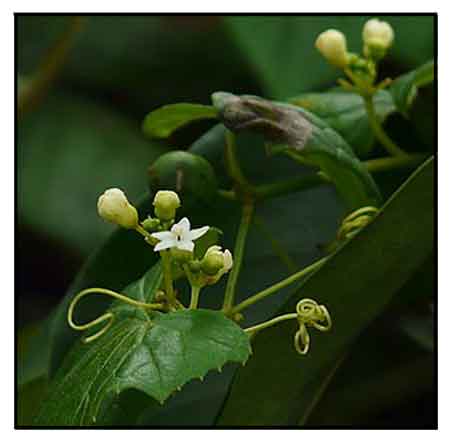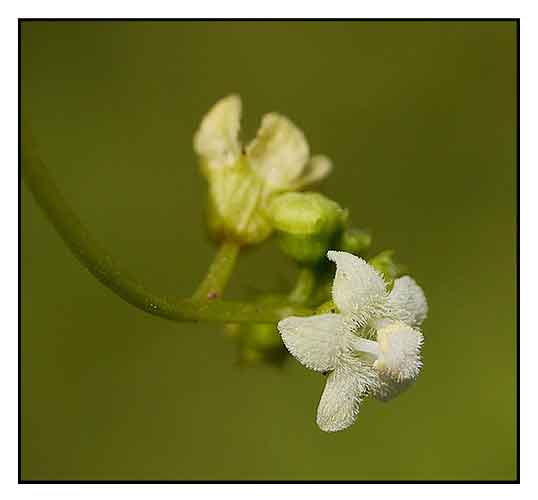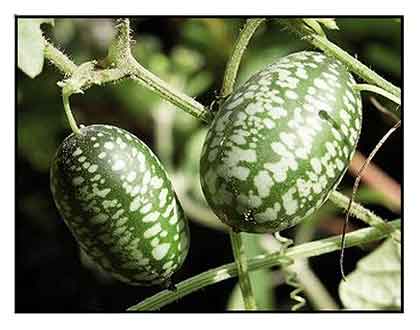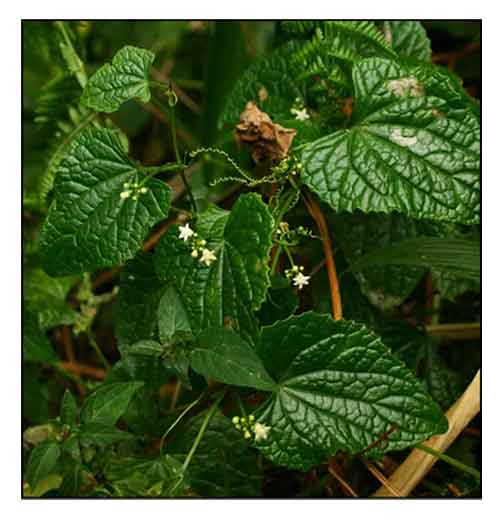 Gen info Gen info
- The genus Zehneria in the family Cucurbitaceae comprises about 94 species distributed from tropical and subtropical Africa, Madagascar, and Asia to Northern Australia and the Pacific Islands.
- Etymology: The genus is named in memory of Joseph Zehner, botanical artist of Vienna
. The species epithet ;scabra is Latin, meaning 'to scratch' referring to its roughness.
Botany
Zehneria scabra is a herbaceous plant that can climb up to 10 m (33 ft) long. The older parts of the stems are woody with corky-ridged bark. Leaves are triangular to ovate in shape, cordate at the base, deep green, and scabrid punctate above. Fruit is oval shaped and bright red.
Zehneria scabra subsp. scabra is a prostrate or climbing herb with annual stems, up to 6 m long. Leaves more or less broadly ovate in outline, usually unlobed but occasionally 3-5-lobed, deep green and with rough hairs above, paler below, cordate at the base; margin prominently toothed. Flowers small, unisexual on different plants; male flowers in axillary clusters; female flowers solitary or in few-flowered clusters, white. Fruit in clusters, spherical, 8-13 mm in diameter, hairless, bright red when ripe.
 Distribution Distribution
- Native to the Philippines. (1)
- Thickets, shrubbery, along streams, grassy roadsides, 300-1000 m elevation.
- Also native to Angola, Assam, Bangladesh, Benin, Burkina, Burundi, Cameroon, Cape Provinces, Congo, Eritrea, Ethiopia, Free State, Gulf of Guinea Is., Himalaya, India, Ivory Coast, Jawa, Kenya, KwaZulu-Natal, Lesotho, Lesser Sunda Is., Liberia, Malawi, Mozambique, Northern Provinces, Rwanda, Saudi Arabia, Somalia, Sudan, Sulawesi, Swaziland, Tanzania, Uganda, Yemen, Zambia, Zaiire, Zimbabwe. (1)
- Widespread in Tropical Africa, South Africa, Arabia, India, Java, and the Philippines.
Constituents
- Phytochemical screening of aqueous and ethanol extracts of tubers yielded phenol +, steroid +, glycosides +, proteins +, amino acids +. Chloroform extract of tubers yielded phenol, tannins, flavonoids, proteins, amino acids. An 80% methanol extract of leaves yielded phenol +, tannins +. saponins +, anthraquinone glycosides, O-anthraquinones, phlobatannins. (5)
 - Phytochemical screening of crude methanol extract of leaves
yielded alkaloids, flavonoids, terpenoids, glycosides, and tannins. (see study below) (7) - Phytochemical screening of crude methanol extract of leaves
yielded alkaloids, flavonoids, terpenoids, glycosides, and tannins. (see study below) (7)
- Phytochemical screening of aqueous and ethanolic extract of tubers yielded phenol, steroids, glycosides, proteins and amino acids, with absence of flavonoids, alkaloids, tannins, and saponins. (see study below)
(9)
- Study of aerial parts isolated two new compounds: 3,10-dihydroxy-5,6-epoxy-ß-ionol (1) and 3,10-dihydroxy-5,6-epoxy-ß-ionyl-10-O-ß-D-glucopyranoside (2) with five known compounds, cucumegastigmane I (3), corchoionoside C (4), indole-3-carboxylic acid (5), methyl indole-3-carboxylate (6) and benzyl-O-ß-D-glucopyranoside (7).
(10)
Properties
- Studies have suggested antidiarrheal, antisecretory, antiplasmodial, antibacterial, antifungal, wound healing properties.
Parts used
Leaves, fruits, seeds, tubers.
 Uses Uses
Edibility
- Tiny cucumbers are edible, consumed fresh or pickled.
Folkloric
- No reported folkloric medicinal use in the Philippines.
-
In Ethiopia, oil from crush fruits and leaves used to treat scabies. Leaves used to treat diarrhea, alopecia and eczema. Also used for wound healing, gonorrhea, syphilis, uterine cleansing, malaria, malaise, constipation, conjunctivitis, fever, eye infections, evil eye and michi.
- For rabies, pounded root of Z. scabra is concocted with pounded root of Ricinus communis. For swellings, leaf and bark of Z. scabra and leaf of Rumex nervosus are pounded and rolled in cloth and tied on swelling. For deworming, filtrate of fresh and crushed leaves is drunk. Tubers consumed for snakebites. (5)
- Roots used for dysmenorrhea.
- Wash from pounded leaves used for treatment of rashes.
- Plant powder applied externally for headaches and stomachaches.
Shoot paste applied to skin rashes.
- Used for treatment of dandruff: Crushed leaves and seeds are mixed with butter, the paste applied to affected areas of the head. (11)
- In Kenya, pressed leaves are rubbed on affected skin. A mixture of leaves of Zehneria scabra and Momordica foetida are boiled, and the patient is covered with a blanket to inhale the vapors for treatment of 'kiplelgutyet' - a condition with a constellation of symptoms: skin itching, general malaise, fever, headache, tremors, dizziness and tinnitus. For ringworm, pressed leaves are rubbed on the affected area of scalp or skin. (12)
Others
- Veterinary: Wash from pounded leaves used to treat calves infested with fleas. (6)
- Tribal practice: Ethiopian tribal people hang roots of Z. scabra in front of their house, believing it will prevent the entry of disease-causing pathogens. (7)
Studies
• Antidiarrheal / Antisecretory / Leaves: Study evaluated the antidiarrheal and antisecretory effects of hydroalcoholic leaf extract of Z. scabra in Swiss albino mice. In castor oil-induced diarrhea model, there was significant reduction in mean stool score at dose of 200 mg/kg. Doses of 100, 200, and 400 mg/kg inhibited stool frequency by 40, 45, and 55%, respectively. All test doses and loperamide (3 mg/g) reduced fecal content significantly (p<0.01). The 100 mg/kg dose caused 25.74% reduction of fluid content (p<0.001) while 200 and 400 mg/kg produced 29.70% reduction. Extract was found safe at dose of 2000 mg/kg in mice. (3)
• Wound Healing / Leaves: Study evaluated 80% methanol extract of air-dried leaves prepared as 5% and 10% ointments for wound healing activity in excision and incision wound models. The 10% w/w extract ointment showed no signs of dermal toxicity. Both 5% and 10% ointment formulations increased percentage wound contraction and tensile strength, and shortened epithelization period. (4)
• Antiplasmodial / Plasmodium berghei / Roots: Study evaluated the antiplasmodial activity of hydroalcoholic crude extract and solvent fractions of Zehneria roots in mice infected with Plasmodium berghei. At all dose levels (200, 400, 600 mg/kg), the crude extract and solvent fractions showed significant (p<0.o5 to p<0.001) chemosuppression, with the crude extract and butanol fraction showing the highest chemosuppression (73.09% and 74.09%, respectively). (6)
• Antibacterial / Leaves: Study evaluated crude methanol extract and fractions of Z. scabra for antibacterial activity against Staphylococcus aureus and Escherichia coli using agar well diffusion method. The chloroform and ethyl acetate fractions revealed more potent antibacterial activity. (see constituents above) (7)
• Anti-Inflammatory / Leaves: Study evaluated the anti-inflammatory activities of 70% ethanol leaves extract and fractions (aqueous AF, butanol BF, chloroform CF) of Z. scabra in rodents. All test doses of the ethanol extract showed significant inhibition of formaldehyde induced arthritis. In carrageenan induced paw edema, all fractions showed statistically significant effect, with the AF being most active. The CF was most active fraction in inhibiting the proliferative and granulomatous component of chronic inflammation in the cotton pellet induced granuloma model. Results indicated the extract and fractions of leaves possessed significant anti-inflammatory activity. (8)
• Antimicrobial / Antifungal / Tubers: Study of solvent extracts from Z. scabra tubers displayed a wide spectrum of antibacterial and antifungal activities. Staphylococcus aureus and Escherichia coli were the most susceptible. All five test fungi i.e., A. fumigatus, A. niger, C. albicans, Mucor sp, and A. flavus showed moderate inhibition. (see constituents above) (9)
Availability
- Wild-crafted.
- Seeds in the cybermarket.
|

![]()







